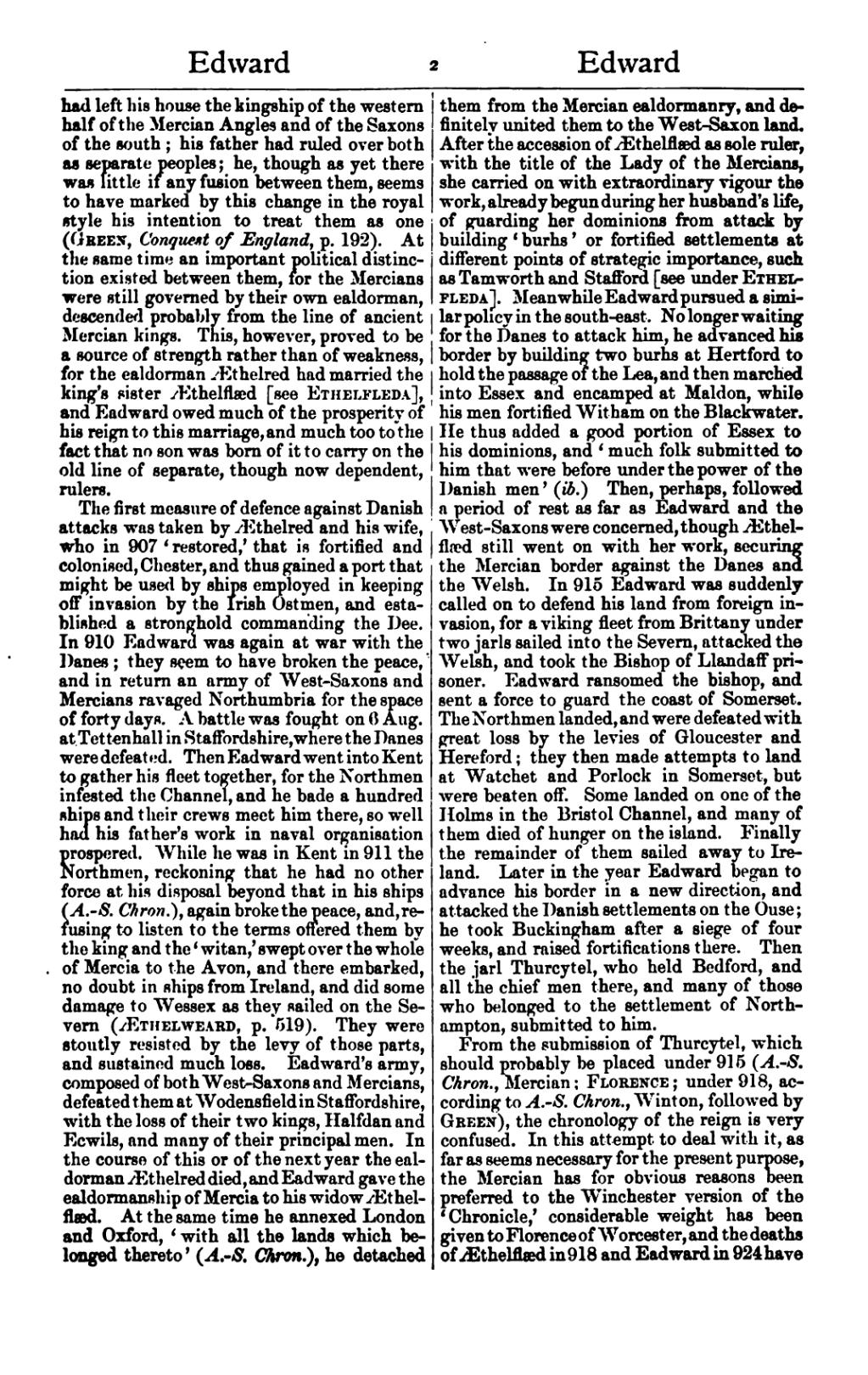had left his house the kingship of the western half of the Mercian Angles and of the Saxons of the south; his father had ruled over both as separate peoples; he, though as yet there was little if any fusion between them, seems to have marked by this change in the royal style his intention to treat them as one (Green, Conquest of England p. 192). At the same time an important political distinction existed between them, for the Mercians were still governed by their own ealdorman, descended probably from the line of ancient Mercian kings. This, however, proved to be a source of strength rather than of weakness, for the ealdorman Æthelred had married the king's sister Æthelflæd [see Ethelfleda, and Eadward owed much of the prosperity of his reign to this marriage, and much too to the fact that no son was born of it to carry on the old line of separate, though now dependent, rulers.
The first measure of defence against Danish attacks was taken by Æthelred and his wife, who in 907 'restored,' that is fortified and colonised, Chester, and thus gained a port that might be used by ships employed in keeping off invasion by the Irish Ostmen, and established a stronghold commanding the Dee. In 910 Eadward was again at war with the Danes; they seem to have broken the peace, and in return an army of West-Saxons and Mercians ravaged Northumbria for the space of forty days. A battle was fought on 6 Aug. at Tettenhall in Staffordshire,where the Danes were defeated. Then Eadward went into Kent to gather his fleet together, for the Northmen infested the Channel, and he bade a hundred ships and their crews meet him there, so well had his father's work in naval organisation prospered. While he was in Kent in 911 the Northmen, reckoning that he had no other force at his disposal beyond that in his ships (A.-S. Chron.), again broke the peace, and,refusing to listen to the terms offered them by the king and the 'witan,' swept over the whole of Mercia to the Avon, and there embarked, no doubt in ships from Ireland, and did some damage to Wessex as they sailed on the Severn (Æthelweard, p. 519). They were stoutly resisted by the levy of those parts, and sustained much loss. Eadward's army, composed of both West-Saxons and Mercians, defeated them at Wodensfield in Staffordshire, with the loss of their two kings, Halfdan and Ecwils, and many of their principal men. In the course of this or of the next year the ealdorman Æthelred died, and Eadward gave the ealdormanship of Mercia to his widow Æthelflæd. At the same time he annexed London and Oxford, 'with all the lands which belonged thereto' (A.S. Chron.), he detached them from the Mercian ealdormanry, and definitely united them to the WestSaxon land. After the accession of Æthelflæd as sole ruler, with the title of the Lady of the Mercians, she carried on with extraordinary vigour the work, already begun during her husband's life, of guarding her dominions from attack by building 'burhs' or fortified settlements at different points of strategic importance, such as Tamworth and Stafford [see under Ethelfleda]. Meanwhile Eadward pursued a similar policy in the south-east. No longer waiting for the Danes to attack him, he advanced his border by building two burhs at Hertford to hold the passage of the Lea, and then marched into Essex and encamped at Maldon, while his men fortified Witham on the Blackwater. He thus added a good portion of Essex to his dominions, and 'much folk submitted to him that were before under the power of the Danish men' (ib.) Then, perhaps, followed a period of rest as far as Eadward and the West-Saxons were concerned, though Æthelflæd still went on with her work, securing the Mercian border against the Danes and the Welsh. In 915 Eadward was suddenly called on to defend his land from foreign invasion, for a viking fleet from Brittany under two jarls sailed into the Severn, attacked the Welsh, and took the Bishop of Llandaff prisoner. Eadward ransomed the bishop, and sent a force to guard the coast of Somerset. The Northmen landed, and were defeated with great loss by the levies of Gloucester and Hereford; they then made attempts to land at Watchet and Porlock in Somerset, but were beaten off. Some landed on one of the Holms in the Bristol Channel, and many of them died of hunger on the island. Finally the remainder of them sailed away to Ireland. Later in the year Eadward began to advance his border in a new direction, and attacked the Danish settlements on the Ouse; he took Buckingham after a siege of four weeks, and raised fortifications there. Then the jarl Thurcytel, who held Bedford, and all the chief men there, and many of those who belonged to the settlement of Northampton, submitted to him.
From the submission of Thurcytel, which should probably be placed under 915 (A.-S. Chron., Mercian; Florence; under 918, according to A.-S. Chron. Winton, followed by Green), the chronology of the reign is very confused. In this attempt to deal with it, as far as seems necessary for the present purpose, the Mercian has for obvious reasons been preferred to the Winchester version of the 'Chronicle,' considerable weight has been given to Florence of Worcester, and the deaths of Æthelflæd in 918 and Eadward in 924 have
